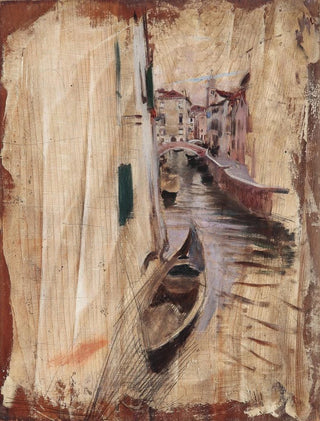Art print | View of a Venetian canal - Giovanni Boldini


View from behind

Frame (optional)
In the enchanting world of Italian painting, "Vue sur un canal vénitien - Giovanni Boldini" stands out for its vibrant atmosphere and timeless elegance. This art print, capturing the magic of a moment in Venice, transports us to the heart of La Serenissima, this city of a thousand reflections and winding canals. Boldini, with his exceptional talent, manages to evoke not only the landscapes but also the very soul of this mythical city. Contemplating this art print, one feels the call of gondolas gliding on the water, the murmur of conversations, and the scent of flowers embellishing the balconies. It is an invitation to immerse oneself in a world where time seems suspended, where each brushstroke tells a story.
Style and uniqueness of the work
Boldini's style is characterized by a remarkable mastery of light and movement. In "Vue sur un canal vénitien," the artist skillfully plays with the reflections on the water, creating harmony between the sky, buildings, and gondolas. The colors, both vivid and delicate, evoke a sensation of lightness, almost ethereal. The composition is carefully orchestrated, each element arranged to emphasize the depth of space and the fluidity of the landscape. Boldini does not limit himself to a simple realistic representation; he infuses his art print with visual poetry that transcends the everyday. Details, such as dancing shadows and flashes of light, testify to meticulous attention, making the whole lively and dynamic. This unique approach makes each viewing experience a renewed one, where the observer constantly discovers new nuances.
The artist and his influence
Giovanni Boldini, often nicknamed the "painter of beautiful ladies," managed to mark his era with his flamboyant style and his ability to capture the quintessence of aristocratic life. Born in 1842 in Ferrara, he settled in Paris where he became one of the most prominent portraitists of the Belle Époque. His influence extends well beyond his contemporaries, inspiring many artists to explore the dynamic between movement and light.

Matte finish

View from behind

Frame (optional)
In the enchanting world of Italian painting, "Vue sur un canal vénitien - Giovanni Boldini" stands out for its vibrant atmosphere and timeless elegance. This art print, capturing the magic of a moment in Venice, transports us to the heart of La Serenissima, this city of a thousand reflections and winding canals. Boldini, with his exceptional talent, manages to evoke not only the landscapes but also the very soul of this mythical city. Contemplating this art print, one feels the call of gondolas gliding on the water, the murmur of conversations, and the scent of flowers embellishing the balconies. It is an invitation to immerse oneself in a world where time seems suspended, where each brushstroke tells a story.
Style and uniqueness of the work
Boldini's style is characterized by a remarkable mastery of light and movement. In "Vue sur un canal vénitien," the artist skillfully plays with the reflections on the water, creating harmony between the sky, buildings, and gondolas. The colors, both vivid and delicate, evoke a sensation of lightness, almost ethereal. The composition is carefully orchestrated, each element arranged to emphasize the depth of space and the fluidity of the landscape. Boldini does not limit himself to a simple realistic representation; he infuses his art print with visual poetry that transcends the everyday. Details, such as dancing shadows and flashes of light, testify to meticulous attention, making the whole lively and dynamic. This unique approach makes each viewing experience a renewed one, where the observer constantly discovers new nuances.
The artist and his influence
Giovanni Boldini, often nicknamed the "painter of beautiful ladies," managed to mark his era with his flamboyant style and his ability to capture the quintessence of aristocratic life. Born in 1842 in Ferrara, he settled in Paris where he became one of the most prominent portraitists of the Belle Époque. His influence extends well beyond his contemporaries, inspiring many artists to explore the dynamic between movement and light.






